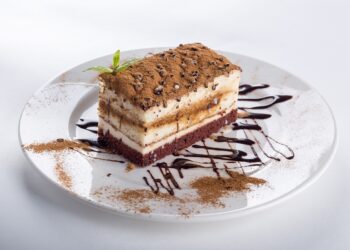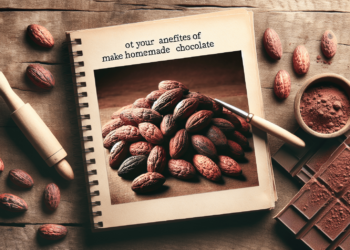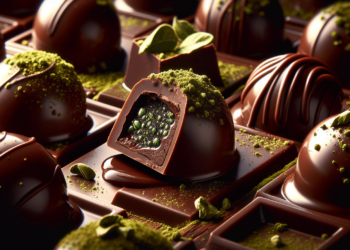So, you’ve got a bit of a sweet tooth and you’re curious to know all about the different types of chocolate out there. Well, you’re in luck because today, we’re going to take a tantalizing trip through the wonderful world of chocolate. From dark and milk to white and beyond, we’ll explore the various types of this delectable treat that will surely satisfy your cravings and make your taste buds dance with delight. Get ready to indulge in a mouthwatering journey as we uncover the 10 types of chocolate you absolutely need to know about. Let’s get started, shall we?
Dark Chocolate
Dark chocolate is a delicious treat that is beloved by many chocolate enthusiasts. It is made from cacao seeds and is known for its rich and intense flavor. Dark chocolate is believed to have originated in Mesoamerica, where it was consumed as a bitter beverage. Today, it is widely enjoyed around the world in various forms such as bars, truffles, and hot chocolate.
Benefits of Dark Chocolate
Not only is dark chocolate a delight for the taste buds, but it also offers several health benefits. One of the most well-known benefits of dark chocolate is its high antioxidant content. Dark chocolate contains flavonoids, which are powerful antioxidants that can help protect the body against free radicals and oxidative stress.
In addition to its antioxidant properties, studies have shown that dark chocolate may have positive effects on cardiovascular health. It has been found to improve blood flow, lower blood pressure, and reduce the risk of heart disease. Dark chocolate is also known to boost mood and improve cognitive function, thanks to the presence of compounds such as caffeine and theobromine.
Popular Dark Chocolate Brands
There are numerous brands that offer delicious dark chocolate options. Some of the most popular ones include Lindt, Ghirardelli, Green & Black’s, and Godiva. These brands are known for their high-quality ingredients and expert craftsmanship, ensuring a delightful and luxurious dark chocolate experience. Whether you prefer a plain dark chocolate bar or a more indulgent truffle, these brands have something for everyone.
Milk Chocolate
While dark chocolate may cater to those with a more intense palate, milk chocolate appeals to a wider range of tastes. Milk chocolate is made by combining cocoa solids, cocoa butter, sugar, and milk powder. This combination results in a smooth and creamy texture that is loved by people of all ages.
Differences between Milk Chocolate and Dark Chocolate
The main difference between milk chocolate and dark chocolate lies in their composition. Unlike dark chocolate, milk chocolate contains milk solids and has a lower percentage of cocoa solids. This gives it a sweeter taste and a lighter color. Milk chocolate is often seen as a more accessible option for those who are not fans of the bitter taste of dark chocolate.
Another difference between the two types of chocolate is their health benefits. While dark chocolate is known for its high levels of antioxidants, milk chocolate tends to have a higher sugar content and fewer health benefits. However, both dark and milk chocolate can be enjoyed in moderation as part of a balanced diet.
Popular Milk Chocolate Brands
When it comes to milk chocolate, there are several iconic brands that come to mind. Hershey’s, Cadbury, Toblerone, and Nestle are just a few examples of well-known milk chocolate brands. These brands offer a variety of milk chocolate products, from classic bars to delightful filled chocolates. Whether you’re craving a simple milk chocolate bar or a more decadent treat, these brands are sure to satisfy your sweet tooth.
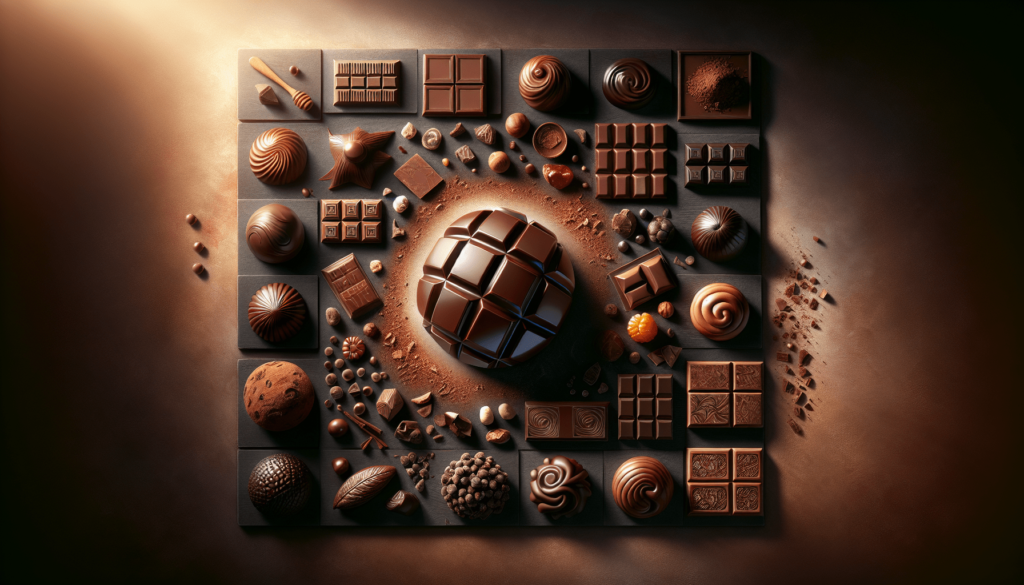
White Chocolate
While some may argue that white chocolate isn’t “real” chocolate due to its lack of cocoa solids, it is still a beloved treat for many. White chocolate is made primarily from cocoa butter, sugar, and milk solids. It has a smooth and creamy texture, and its flavor is sweet and vanilla-like.
Ingredients used in White Chocolate
The creamy and decadent texture of white chocolate is achieved by using cocoa butter as its main ingredient. Cocoa butter is the fat extracted from cocoa beans and is what gives chocolate its smoothness. In addition to cocoa butter, white chocolate also contains sugar and milk solids, which contribute to its sweet and milky taste.
Controversies Surrounding White Chocolate
White chocolate has been a topic of debate among chocolate enthusiasts. Some argue that it isn’t “real” chocolate since it lacks cocoa solids, which are responsible for the characteristic flavor of chocolate. However, others argue that white chocolate is a valid and enjoyable treat in its own right.
While white chocolate may not be as popular as its dark and milk counterparts, it still has a dedicated following. Whether you view it as true chocolate or not, there’s no denying the delightfulness of a creamy and sweet white chocolate truffle or bar.
Chocolate Truffles
Chocolate truffles are a decadent and indulgent treat loved by chocolate connoisseurs. These bite-sized delights are usually made from a mixture of chocolate, cream, and butter, and are then coated in cocoa powder or other toppings. The name “truffle” comes from their resemblance to the truffle fungus found in the ground.
How Chocolate Truffles are Made
The process of making chocolate truffles begins with melting high-quality chocolate and combining it with warm cream and butter. This mixture is then chilled until it becomes firm enough to be shaped into small balls. The truffles are then rolled in cocoa powder, giving them their distinctive appearance.
Chocolate truffles can be flavored in a variety of ways. Popular flavors include classic dark chocolate, milk chocolate, white chocolate, and various combinations of fruits, nuts, and spices. Some truffles are also infused with liqueurs or extracts to add an extra layer of flavor.
Popular Flavors of Chocolate Truffles
The world of chocolate truffles offers an array of flavors to suit every palate. From classic dark chocolate truffles to more adventurous combinations, there is something for everyone. Popular flavors include salted caramel, raspberry, hazelnut, mint, and orange, to name just a few. Whether you prefer a simple and rich chocolate bite or an exotic flavor explosion, chocolate truffles have something to satisfy all taste buds.
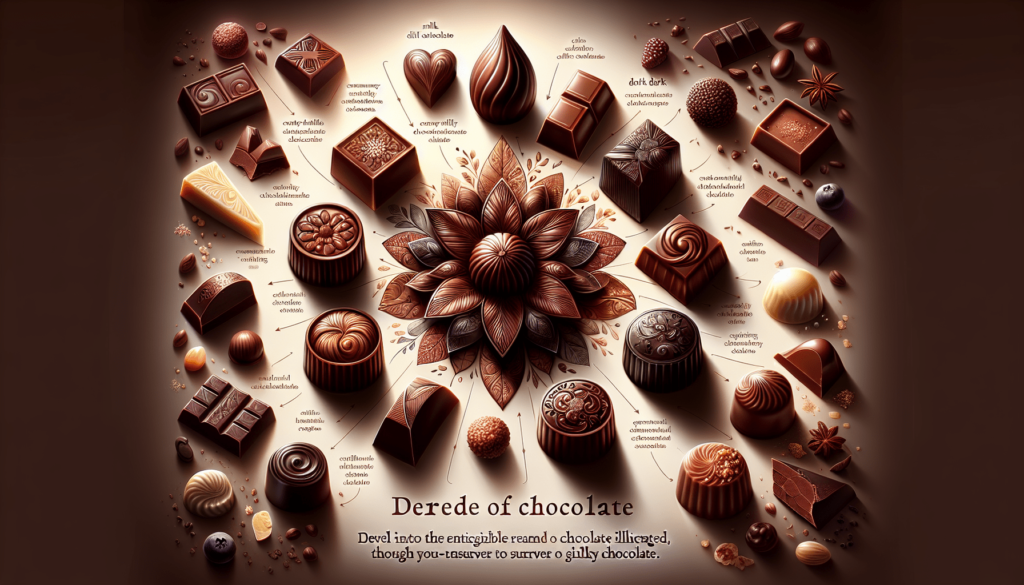
Chocolate Bars
Chocolate bars are perhaps the most familiar and widely consumed form of chocolate. They come in a variety of shapes, sizes, and flavors, making them a versatile option for chocolate lovers of all ages. Chocolate bars are typically made by melting chocolate and pouring it into molds, where it is left to cool and harden.
Different Varieties of Chocolate Bars
Chocolate bars come in a multitude of varieties to cater to different preferences. Some popular types include milk chocolate bars, dark chocolate bars, and white chocolate bars. Within each category, there are further variations such as bars with added nuts, fruits, or spices. Additionally, there are specialty chocolate bars made with higher percentages of cocoa and unique flavors, appealing to those with a more discerning palate.
Famous Chocolate Bar Brands
When it comes to chocolate bars, there are numerous brands that have become synonymous with quality and taste. Hershey’s, Cadbury, Mars, and Nestle are just a few examples of iconic chocolate bar brands. These brands offer a wide range of options, from classic plain chocolate bars to bars filled with caramel, nuts, or nougat. Whether you prefer a simple and straightforward chocolate bar or one with a delicious surprise inside, these brands have something to satisfy every chocolate craving.
Chocolate Bonbons
Chocolate bonbons, also known as chocolate truffles, are small confections that are typically filled with flavored ganache, caramel, or other delightful fillings. They are often coated in chocolate or cocoa powder, and their small size makes them perfect for indulging in just the right amount of sweetness.
Explanation of Chocolate Bonbons
The term “bonbon” is derived from the French word for candy. Chocolate bonbons are made by filling small chocolate shells with a variety of sweet fillings, which can include ganache, fruit puree, caramel, or nougat. The filled shells are then sealed with more chocolate, creating a perfect bite-sized treat.
Techniques Used to Create Bonbons
Creating chocolate bonbons is a delicate and precise process that requires skill and attention to detail. The process begins with tempering the chocolate, which involves heating and cooling the chocolate to a specific temperature to give it a glossy finish and a crisp texture. The tempered chocolate is then poured into molds to create the outer shell.
Once the chocolate shell is formed, it is filled with the desired filling, and then sealed with more chocolate. The filled bonbons are then left to set before being decorated or coated with cocoa powder. The end result is a visually appealing and delicious treat that is sure to impress.
Assortment of Flavors in Bonbons
Chocolate bonbons come in a wide variety of flavors to suit every taste. From classic flavors like dark chocolate and caramel to more unique combinations, there is no shortage of options. Some popular flavors include hazelnut, salted caramel, raspberry, coffee, and praline. With such a diverse range of flavors, there is always something new and exciting to try when it comes to chocolate bonbons.
Chocolate Covered Fruits
Chocolate covered fruits are a delightful combination of the natural sweetness of fruit and the rich indulgence of chocolate. They make for a perfect balance between healthy and indulgent, and are a popular choice for special occasions or as an everyday treat.
Varieties of Fruits Covered in Chocolate
There are numerous fruits that can be coated in chocolate to create a delicious and visually appealing treat. Some popular choices include strawberries, bananas, cherries, oranges, and pineapple. These fruits are often dipped in melted chocolate and left to harden, resulting in a crunchy and sweet coating that perfectly complements the natural flavors of the fruit.
Benefits of Chocolate Covered Fruits
In addition to being a tasty treat, chocolate covered fruits also offer some health benefits. Fruits are packed with vitamins, minerals, and fiber, and when combined with dark chocolate, which contains antioxidants, the result is a treat that is both delicious and nutritious. Additionally, the natural sugars found in fruits can help satisfy a sweet tooth in a healthier way compared to more processed sweets.
Tips for Making Chocolate Covered Fruits at Home
Making chocolate covered fruits at home is a fun and rewarding activity. Here are a few tips to ensure success:
-
Choose ripe and firm fruits: Using ripe and firm fruits will ensure that they hold their shape well and provide the best texture.
-
Melt the chocolate properly: To achieve a smooth and glossy coating, it is important to melt the chocolate gently and avoid overheating. Use a double boiler or a microwave-safe bowl and heat the chocolate in short bursts, stirring frequently.
-
Prepare the fruits: Wash and dry the fruits thoroughly before dipping them in chocolate. This will help the chocolate adhere better and prevent any potential contamination.
-
Allow to set: After coating the fruits in chocolate, place them on a parchment-lined tray and allow them to set at room temperature or in the refrigerator. This will ensure that the chocolate hardens and maintains its shape.
By following these tips, you can create your own delicious chocolate covered fruits at home and enjoy a healthier alternative to store-bought treats.
Hot Chocolate
Hot chocolate is a comforting and indulgent beverage that is perfect for warming up on a chilly day or as a delightful treat any time of the year. It has a rich and velvety texture, and its flavors can range from classic and simple to complex and gourmet.
Different Types of Hot Chocolate Drinks
Hot chocolate comes in various forms, each with its own unique characteristics. Traditional hot chocolate is made by combining milk or water with cocoa powder and sugar, while hot chocolate made with melted chocolate offers a more decadent and luxurious experience. Other variations include Mexican hot chocolate, which is infused with spices such as cinnamon and chili powder, and white hot chocolate, which is made with white chocolate rather than cocoa powder or melted chocolate.
Popular Toppings and Variations
Hot chocolate can be customized with a variety of toppings and flavors to suit individual preferences. Some popular toppings include whipped cream, marshmallows, shaved chocolate, caramel sauce, and sprinkles. For those seeking an extra kick, a dash of flavored liqueur such as peppermint or hazelnut can be added to the hot chocolate. The possibilities are endless when it comes to creating a personalized and delightful cup of hot chocolate.
Origins of Hot Chocolate
Hot chocolate has a long and rich history that dates back to ancient civilizations. The Mayans and Aztecs were known to have consumed a bitter and spiced beverage made from ground cacao beans and water. This early form of hot chocolate was considered a luxury and was often reserved for ceremonial or religious purposes.
As the beverage made its way to Europe, it began to evolve, with the addition of sugar and milk to sweeten and lighten the flavor. The popularity of hot chocolate grew rapidly, and it soon became a staple in European households. Today, hot chocolate is enjoyed around the world in various forms, each with its own unique twist on this timeless beverage.
Chocolate Fondue
Chocolate fondue is a delightful and interactive dessert that is perfect for sharing with friends and family. It involves dipping a variety of dippable items into melted chocolate, resulting in a fun and indulgent experience.
Explanation of Chocolate Fondue
Chocolate fondue is an interactive dessert where a pot of melted chocolate is placed in the center of a table, and participants dip various dippable items into the chocolate using long forks or skewers. The dipping items can include fruits, marshmallows, pretzels, cookies, and even pieces of cake or brownies. The melted chocolate creates a delicious and smooth coating on the dipped item, making it a delight to eat.
Various Dippable Items for Chocolate Fondue
The beauty of chocolate fondue lies in the variety of dippable items that can be enjoyed with melted chocolate. Some popular choices include:
-
Fruits: Strawberries, bananas, pineapples, and apples are just a few examples of fruits that pair perfectly with chocolate. The combination of the natural sweetness of the fruit and the creamy richness of the chocolate is a match made in heaven.
-
Marshmallows: Soft and fluffy marshmallows take on a whole new level of deliciousness when dipped in warm, melted chocolate. The contrast between the smooth chocolate and the pillowy marshmallow is simply irresistible.
-
Pretzels: The salty and crunchy texture of pretzels creates an interesting contrast when combined with the sweetness of chocolate. It’s a delightful combination that keeps you coming back for more.
-
Cookies: From classic chocolate chip cookies to buttery shortbread cookies, the possibilities for dipping cookies into chocolate are endless. The marriage of cookie and chocolate creates a delectable treat that is hard to resist.
-
Cake or Brownies: For those who prefer a more indulgent option, slices of cake or brownies can be dipped into chocolate fondue. The combination of moist cake or fudgy brownies with the velvety smoothness of the chocolate is pure decadence.
Tips for Hosting a Chocolate Fondue Party
Hosting a chocolate fondue party can be a fun and memorable experience. Here are a few tips to ensure that your fondue party is a success:
-
Choose a variety of dippable items: Offer a diverse selection of fruits, cookies, pretzels, and other dippable items to cater to different tastes and dietary preferences.
-
Use high-quality chocolate: The quality of the chocolate used for fondue can make a significant difference in the flavor and texture of the melted chocolate. Opt for high-quality chocolate with a higher cocoa content for a truly indulgent experience.
-
Keep the chocolate warm: Use a fondue pot or a slow cooker to keep the melted chocolate warm throughout the duration of the party. This will ensure a smooth and consistent dipping experience.
-
Provide an assortment of toppings: Alongside the melted chocolate, offer a variety of toppings such as shredded coconut, chopped nuts, or sprinkles to enhance the flavor and texture of the dipped items.
-
Have plenty of napkins and wet wipes: Dipping things into melted chocolate can get messy, so be prepared with plenty of napkins or wet wipes for guests to clean their hands or utensils.
By following these tips, you can host a memorable chocolate fondue party that will be enjoyed by all.
Healthier Chocolate Options
While chocolate is often associated with indulgence, there are healthier options available for those looking to satisfy their chocolate cravings without the guilt. These alternatives offer a more balanced approach to enjoying chocolate while still providing a dose of sweetness and satisfaction.
Introduction to Healthier Chocolate Options
Healthier chocolate options are typically lower in sugar and higher in beneficial components such as antioxidants and fiber. These options can be a great way to enjoy the flavors and benefits of chocolate while incorporating it into a balanced and nutritious diet.
Sugar-Free and Low-Sugar Chocolate Alternatives
For those looking to reduce their sugar intake, sugar-free and low-sugar chocolate alternatives are available. These products are sweetened with natural sweeteners such as stevia or erythritol, which provide the sweetness without the added calories or blood sugar spike. It’s important to note that sugar-free does not always mean calorie-free, so portion control is key when enjoying these alternatives.
Dark Chocolate with Higher Cacao Content
Dark chocolate with higher cacao content is another healthier option for chocolate lovers. Dark chocolate with at least 70% cocoa solids has a higher concentration of antioxidants and less sugar compared to milk chocolate. It also has a more intense and complex flavor profile. The bitterness of dark chocolate may take some getting used to for those with a sweeter palate, but once acquired, it can be a delightful and satisfying treat.
When choosing dark chocolate, it’s important to look for brands that use high-quality ingredients and have minimal added sugars or artificial additives.
In conclusion, the world of chocolate is vast and filled with delicious possibilities. From the rich and intense flavors of dark chocolate to the creamy sweetness of milk chocolate and white chocolate, there is something for everyone. Whether you prefer classic chocolate bars, indulgent truffles, or interactive fondue experiences, chocolate is a treat that brings joy and satisfaction.
While it’s important to enjoy chocolate in moderation, there are also healthier options available for those looking to include chocolate in a balanced diet. Sugar-free and low-sugar alternatives, as well as dark chocolate with higher cacao content, offer a more nutritious and guilt-free way to indulge in the flavors of chocolate.
So go ahead, embrace your love for chocolate and explore the wonderful world of diverse flavors, textures, and experiences that it has to offer. Whether you’re enjoying a simple chocolate bar or getting creative with homemade chocolate-covered fruits or fondue, let chocolate be a source of joy and delight in your life.

